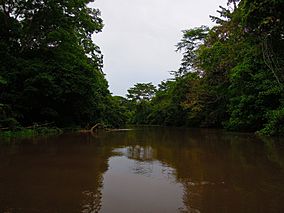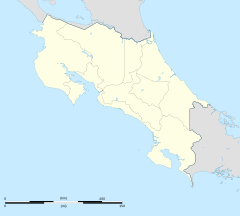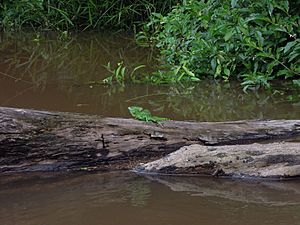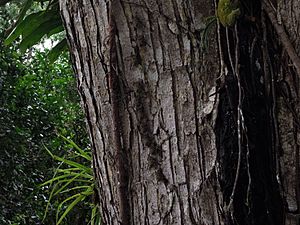Caño Negro Wildlife Refuge facts for kids
Quick facts for kids Caño Negro Wildlife Refuge |
|
|---|---|
|
IUCN Category IV (Habitat/Species Management Area)
|
|

View of Caño Negro Wildlife Reserve
|
|
| Location | Alajuela Province, Costa Rica |
| Nearest city | Upala |
| Area | 25,100 acres (102 km2) |
| Established | 1984 |
| Governing body | National System of Conservation Areas (SINAC) |
| Official name: Caño Negro | |
| Designated: | 27 December 1991 |
| Reference #: | 541 |
The Caño Negro Wildlife Refuge is a special protected area in northern Costa Rica. It's like a safe home for many animals and plants. This refuge is about 20 kilometers (12 miles) south of a town called Los Chiles, close to the border with Nicaragua. It's located in the Alajuela province.
This amazing place is mostly a wetland, which means it has lots of water, like swamps and marshes. It's super important for many migratory birds, especially waterfowl (birds that live near water). They come here to rest and find food during different times of the year. The heart of the refuge is Lake Caño Negro, which gets its water from the Frío River when it rains a lot.
Contents
Getting to Caño Negro Wildlife Refuge
You can reach the Caño Negro Wildlife Refuge by using Route 138. This road connects to two other main roads, Route 4 and Route 35.
Exploring the Refuge
There are no public buildings or facilities inside the refuge itself. The best way to explore this natural wonder is by boat. There's a special dock where boats can stop. You can find places to stay and other services in the nearby town of Caño Negro.
Amazing Animals of Caño Negro
The forests, grasslands, and wet areas of the refuge are home to many different animals. Some of these animals are rare or endangered, meaning they need special protection.
Here are some of the cool animals you might find:
- Big Cats: You might spot powerful cougars, jaguars, and ocelots.
- Other Mammals: Look for tapirs (large pig-like animals) and peccary (wild pigs).
- Monkeys: Three types of monkeys live here:
- Panamanian white-faced capuchins (they have white faces!)
- Mantled howlers (known for their loud calls)
- Geoffroy's spider monkeys (they have long arms and tails)
Migratory Birds in the Dry Season
When the dry season arrives, the Frío River gets smaller. It turns into little lagoons, channels, and sandy areas. This creates perfect spots for thousands of migratory birds. They come here from far away to find food and shelter.
You can see many different kinds of birds, such as:
- Storks
- Spoonbills (they have spoon-shaped beaks!)
- Ibis
- Anhingas
- Many types of ducks
- Cormorants
See also
 In Spanish: Refugio nacional de vida silvestre Caño Negro para niños
In Spanish: Refugio nacional de vida silvestre Caño Negro para niños




